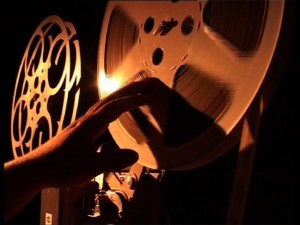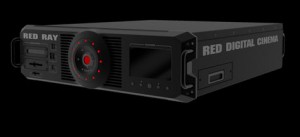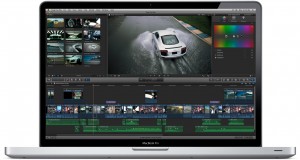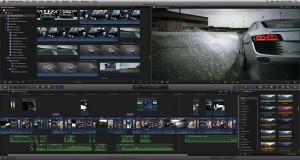 flying in
flying in
verb \ˈflī – iŋ ˈin\ – common call on a film set indicating that a specific tool or piece of equipment is being brought on set | acknowledgement of a request to “fly in ____”
A true Chewer is marked by a curiosity into every aspect of filmmaking, from theory to craft. To put a little more spotlight on the latter, I bring you Flying In – a wide lensed look at the various developments and goings on in the film tech world. Some of the things covered will be on the DIY, indie filmmaking level and others will be at the cutting edge, but it will all be interesting.
• RED RAY 4K Playback System •
 Digital projection is on the march, and even those that maintain quibbles with digital image capture, 3D, etc etc. would agree that a proper 4K digital project is a stunning way to watch a film. Eliminating generational quality degradation (the idea that every step away from the original film stock you get, the more quality you’re losing) as well as the inherent micro-jitter of projector with moving parts, the quality of the viewing experience is more than enough reason for the vast majority of projection to become digital. The problem is, despite the savings of tens of thousands of dollars per print and lessened shipping costs, the upfront costs to move to digital projection are prohibitively expensive. Even the major chains have had to team up with each other, navigate negotiations for cost-sharing with the studios that would make Israel and Palestine nervous, and take out enormous loans to convert even a portion of their theaters. For the one-screeners, regional cinemas, and independent art houses it’s even more difficult to jump on the digital bandwagon, as the projectors are costly, and the digital delivery systems are so proprietary and expensive they are effectively shut out.
Digital projection is on the march, and even those that maintain quibbles with digital image capture, 3D, etc etc. would agree that a proper 4K digital project is a stunning way to watch a film. Eliminating generational quality degradation (the idea that every step away from the original film stock you get, the more quality you’re losing) as well as the inherent micro-jitter of projector with moving parts, the quality of the viewing experience is more than enough reason for the vast majority of projection to become digital. The problem is, despite the savings of tens of thousands of dollars per print and lessened shipping costs, the upfront costs to move to digital projection are prohibitively expensive. Even the major chains have had to team up with each other, navigate negotiations for cost-sharing with the studios that would make Israel and Palestine nervous, and take out enormous loans to convert even a portion of their theaters. For the one-screeners, regional cinemas, and independent art houses it’s even more difficult to jump on the digital bandwagon, as the projectors are costly, and the digital delivery systems are so proprietary and expensive they are effectively shut out.
RED is of course known for their game-changing camera systems (including their latest release that is currently active on sets like The Hobbit, and The Amazing Spider-Man), but they’re also very active in building everything from proprietary hard drives and batteries, to computer processors. The RED RAY is a recently announced processing unit that will allow smaller theaters to handle digital films in a variety of formats and qualities. The job of the RAY will be to accept the digital files for the films themselves and act as the playback device (meaning you may literally bring a film on a USB stick and play it out to a 4K projector). There is a pro model priced at around $7,500, and a consumer version that will retail for less than a thousand. The consumer model will still be capable of outputting 4K, but across several HDMI hookups instead of a more advanced interface. It also looks like it’s geared to handle h.264 and 1080p media more specifically than the Pro versions native handling of RED files (meaning it’s also useful on RED sets for immedate, full quality playback from CF cards and SSD).
While you still have to cough up for a projector, a more accepting playback unit for a fraction of the usual cost will make digital projection an option for many more theaters.
Find out more information on RED’s Website (the consumer model isn’t currently described) and thanks to Digital Film School for catching up on this at NAB.
• 360-Degree Panorama Camera Attachment •
 Panorama’s are a popular photographic trick, as more and more smartphone apps allow people to construct them out of a series of photos. If you’re rocking a DSLR or other high-tech camera, there’s a kit available that will allow you to capture panoramic imagery all at once with lenses of your choice. It’s called the EyeSee360 GoPano kit (fucking A, I hate cute/dumb tech product names) and it affixes a specially molded spherical mirror to the end of your camera lens, and allows the image sensor to capture a warped view of the whole world! Or at least most of it. This works for photo and video, and the GoPano software will decode the photos or video into interactive panoramic images. For $700.00 to $1100.00 bucks (depending on if you go only photo, or video as well), there’s a whole lot proprietary shit involved, but it’s still a cool effect that you can demonstrated on the B&H Photo page for the device.
Panorama’s are a popular photographic trick, as more and more smartphone apps allow people to construct them out of a series of photos. If you’re rocking a DSLR or other high-tech camera, there’s a kit available that will allow you to capture panoramic imagery all at once with lenses of your choice. It’s called the EyeSee360 GoPano kit (fucking A, I hate cute/dumb tech product names) and it affixes a specially molded spherical mirror to the end of your camera lens, and allows the image sensor to capture a warped view of the whole world! Or at least most of it. This works for photo and video, and the GoPano software will decode the photos or video into interactive panoramic images. For $700.00 to $1100.00 bucks (depending on if you go only photo, or video as well), there’s a whole lot proprietary shit involved, but it’s still a cool effect that you can demonstrated on the B&H Photo page for the device.
The results of this trick are pretty unique, and if you’re looking for something new to experiment with in your photography or videography, this might be worth a shot.
• Final Cut Pro X Teased By Apple •
 Big news has been a brewin’ in the post-production world, as Apple finally let out some details about the forthcoming update of Final Cut Pro, their flagship post-production suite. As you may or may not know, Apple has actually carved out a significant position in the post-production technology field, which was for so long dominated exclusively by AVID. While FCP has not taken over the industry in the way their more consumer-geared products tend to, it has definitely made non-linear, non-destructive editing accessible to many more people and is certainly the go-to application for low-budget professionals. That said, famous filmmakers like David Fincher have been using the system for years now, while it was famously used for Walter Murch’s Oscar-winning Cold Mountain edit. All of this to say that Final Cut Pro has rightfully challenged AVID, and a new version of the software is a big deal.
Big news has been a brewin’ in the post-production world, as Apple finally let out some details about the forthcoming update of Final Cut Pro, their flagship post-production suite. As you may or may not know, Apple has actually carved out a significant position in the post-production technology field, which was for so long dominated exclusively by AVID. While FCP has not taken over the industry in the way their more consumer-geared products tend to, it has definitely made non-linear, non-destructive editing accessible to many more people and is certainly the go-to application for low-budget professionals. That said, famous filmmakers like David Fincher have been using the system for years now, while it was famously used for Walter Murch’s Oscar-winning Cold Mountain edit. All of this to say that Final Cut Pro has rightfully challenged AVID, and a new version of the software is a big deal.
The actual presentation and released details have raised as many questions as they’ve answered though, as many of the new features seem interesting but don’t address long-time complaints. Without getting too in-depth, the suite still seems to cater to professionals, but doesn’t seem to be focusing on making strides with ultra-professionals. Rather than making FCP a more communicative program with higher-level specialized programs, Apple has focused on making it more of an all-in-one tool that refines certain elements of video workflow, making advanced features more intuitive. A list of some key features…
• Background rendering – the program is rendering constantly, and won’t require you to wait for playback
• Ingestion processing – clips will be more thoroughly analyzed for stabilization and other features as they come into the program in the first place
• SD to 4K resolution
• Automated recognition of composition (it can detect faces and people, and what kind of shot they are in)
• More natively supported formats (DSLR no longer requires compression, for example)
…and that’s just the tip of the iceberg. Because this was as much an announcement as a preview, there are still many features to be revealed or explained.
 There’s been some great analysis of the visible changes by several professional editors that are worth checking out..
There’s been some great analysis of the visible changes by several professional editors that are worth checking out..
NoFilmSchool discusses the importance of escaping bad habits and bad standards
Pro Editor Matt Toder of Gawker.TV overdoes it a bit as he explains why FCP X will send him back to AVID. Kind of a dumb opinion to take at this point, but he raises very legit questions.
Larry Jordan is a FCP professional, and he raises many concerns and celebrates many features of FCP.
I use FCP nearly every day, so I’m pretty excited to take a look at the new suite when the details are more clear. That said, a lot of the nitpicky quirks of FCP that I have a problem with don’t look like they’re the key focus of the new software, so I can only hope those fixes are among the many new things written into the program. I’m attracted to the abilities of FCP X to more effectively use multi-core processing, and it’s dispensing of episodic rendering, but a lot of these are features that Adobe’s Premiere Pro 5 has been doing for some time now. I watched Adobe demo that program almost a year ago and the 64-bit capabilities blew me away. It’s too soon to tell if FCP X is truly keeping up, or just refining the same ole, same ole with the usual Apple polish and hype.
• Technicolor Partners with Canon for DSLR Color Profiles •
 This is pretty cool for us DSLR shooters…
This is pretty cool for us DSLR shooters…
Canon has teamed up with Technicolor to develop a FREE firmware-update that creates a CineStyle picture profile on the popular Canon cameras (5DmII, 7D, 60D, etc) that allows videographers to retain more information about latitude and dynamic range in the video files, giving them much more power in post-production. Canon’s DSLRs are notorious for creating very beautiful, pleasing images very easily/immediately, but being shit for color-correction. The compression the images go through means that very little color/latitude data is retained, which means by the time you get the files into the computer and start shoving pixels around, there’s nowhere for you to go. Now these DSLRs will resemble more professional motion-picture cameras by giving a colorist more raw information to work with, resulting ultimately in more cinematic-quality output.
This isn’t a big deal for your one-and-done DSLR video-shooter as the immediate results of the picture profile are… well, ugly. It’s only in the color-correction that the information will benefit the user.
Take a look at this video (picked up on DSLR News Shooter via NoFilmSchool once again) of the Technicolor rep explaining how this all works…
PLEASE let me know what you guys think of this column. Are there some pro’s that find this kind of rundown useful? Are there casual readers that find this kind of thing fascinating?
If you catch on to any news, developments, or items that you feel should be covered, please SUBMIT them to me.
Hopefully there’s some interesting, because I enjoy the shit out of collecting it!
DISCUSS THIS on the CHUD Message Board
&
Like / Share it on Facebook (above or below) if you think it’s great!